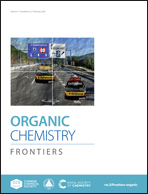Isolation and characterization of an annelated N-heterocyclic carbene stabilized Breslow enolate†
Abstract
Deprotonated Breslow intermediates (Breslow enolates) have recently been recognized as active single-electron transfer (SET) reductants in N-heterocyclic carbene (NHC) catalyzed radical reactions. Although Breslow enolates have been produced by electrolysis and confirmed by ultraviolet-visible spectroscopy, the isolation and crystallographic study of these species remains a challenge due to their high reactivity. Taking advantage of the electronic properties of annelated NHCs, we have successfully isolated the first Breslow enolate (4a−) derived from bis(imino)acenaphthene-supported NHC (IPr(BIAN)) as a black crystalline solid. The synthesis of 4a− involves the one-electron reduction of the corresponding ketyl radical (3a) using KC8, which can be regarded as the reverse of a SET event between Breslow enolates and ketyl radicals in NHC-catalyzed radical reactions. In addition, the measured half-life of 3a in well-aerated solutions was more than 500 times higher than those of classical NHC (imidazolidin-2-ylidene and imidazol-2-ylidene) supported radical congeners. The present study demonstrates the beneficial role of IPr(BIAN) in stabilizing Breslow enolates as well as ketyl radicals and provides a model system for studying NHC-catalyzed radical reactions.



 Please wait while we load your content...
Please wait while we load your content...